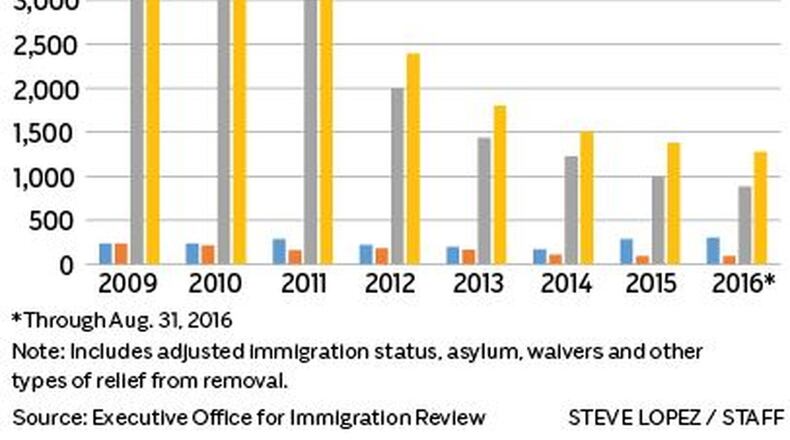In fiscal year 2009, the immigration court in Cleveland deported 4,149 people from Ohio and granted relief — usually asylum or adjusted immigration status — in 236 cases. By 2015, deportations had dropped to 998 and relief was granted in 92 cases.
RELATED: Trump orders could impact 100+ immigrants in local jail
The Obama administration focused enforcement on people who recently entered the country – and were close to the border – and also on those with serious criminal convictions.
The number of cases in Ohio and throughout the country could rise dramatically thanks to changes underway by the Trump administration.
Those changes, outlined in a pair of memos released last week by U.S. Department of Homeland Security Secretary John Kelly, include shifting priorities to anyone accused of any level of crime anywhere in the country, increasing expedited removals and hiring an additional 10,000 U.S. Immigration and Customs Enforcement agents and 5,000 new border agents.
RELATED: 11 immigration policy changes that could impact local enforcement
The news of tougher immigration enforcement was applauded by those who want more border protections and increased vetting of immigrants entering the country. But it’s had a chilling effect on those who have been here for years raising their families and building a life, said Kathleen Kersh, an immigration attorney with Advocates for Basic Legal Equality.
“People are afraid to go to church,” she said. “They are afraid to go to the grocery store. Kids are afraid to go to school.”
Many of those facing immigration charges in Ohio were brought here by ICE because they have family in the area, giving them a place to stay after they bond out. With the huge backlog of cases, some wait years before their case is even heard.
Kersh worries increased enforcement will further burden the clogged immigration court in Cleveland, where three judges handle thousands of cases. One reason immigration orders have decreased, she said, is that judges have to keep pushing back hearings to take on new cases.
RELATED: Dayton cops ‘will get disciplined’ for asking about immigration status
“It’s very normal for a client to get a hearing date two and a half or more years in the future,” she said.“Cleveland is one of the more backlogged courts in the United States.”
Court records show new immigration matters brought before the Cleveland court rose from 5,704 in 2010 to 6,179 in 2011, then steadily decreased to 2,667 in 2014. The backlog persists, attorneys say, because cases take so many years to get through the system.
Kelly’s memo notes that there are more than half a million cases pending on immigration dockets nationwide, with the average case taking two years and many cases taking five years.
To address this, he plans to increase “expedited removal” of people who are inadmissible to the U.S. and can’t prove they have been in the country for at least two years.
Under Obama, this was only used for people in the country less than 14 days and less than 100 miles from the Mexico border.
RELATED: 5 people from ‘banned’ countries in area jail; Here’s why they’re there
Butler County Sheriff Richard K. Jones says he has no interest in tearing apart peaceful immigrant families. But his officers need to be able to identify drug-runners and other criminals exploiting America’s confusing immigration laws, he said.
Jones has offered his department up as first in line for a program, called 287(g), that trains and deputizes local law enforcement officers to enforce federal immigration law.
Kelly’s memo includes reinstating the 287(g) program as part of Trump’s expanded enforcement of immigration laws. The program was dialed back under Obama.
Jones said under the 287(g) program his officers can get more training and be better equipped to identify when someone accused of a local crime is also in violation of immigration law.
“Law enforcement officers have no idea who they’re stopping,” he said. “They have no idea what a real visa looks like, or a work permit, or a green card – they’re not green,” he said. “It’s a total mess. (They want to know) was this person deported? Are they back? Are they wanted for rape? Are they wanted for murder?”
Even so-called “law-abiding” illegal immigrants often break the law all the time, according to Jones. They are here illegally. They drive without a license. They often work with fake paperwork or don’t pay taxes, he said.
Jones said increased enforcement will lead to the need for more jail beds, more judges, “more everything.”
But while the changes are designed to make the nation safer, Kersh said they could prove to be an inpediment to solving some crimes.
She said she gets calls every week from illegal immigrants who are victims or witnesses to crimes but are afraid to call the police. None of her current undocumented clients have convictions for violent crimes, she said, but many were victims of crimes who helped bring the perpetrator to justice.
“If they’re not reporting that criminal activity, that makes the whole community less safe,” she said. “We need immigrants to be our allies.”
RECENT I-TEAM STORIES ON IMMIGRATION:
This newspaper shines a spotlight on issues involving local jails and public safety. For more of these stories, go to myDaytonDailyNews.com.
About the Author

